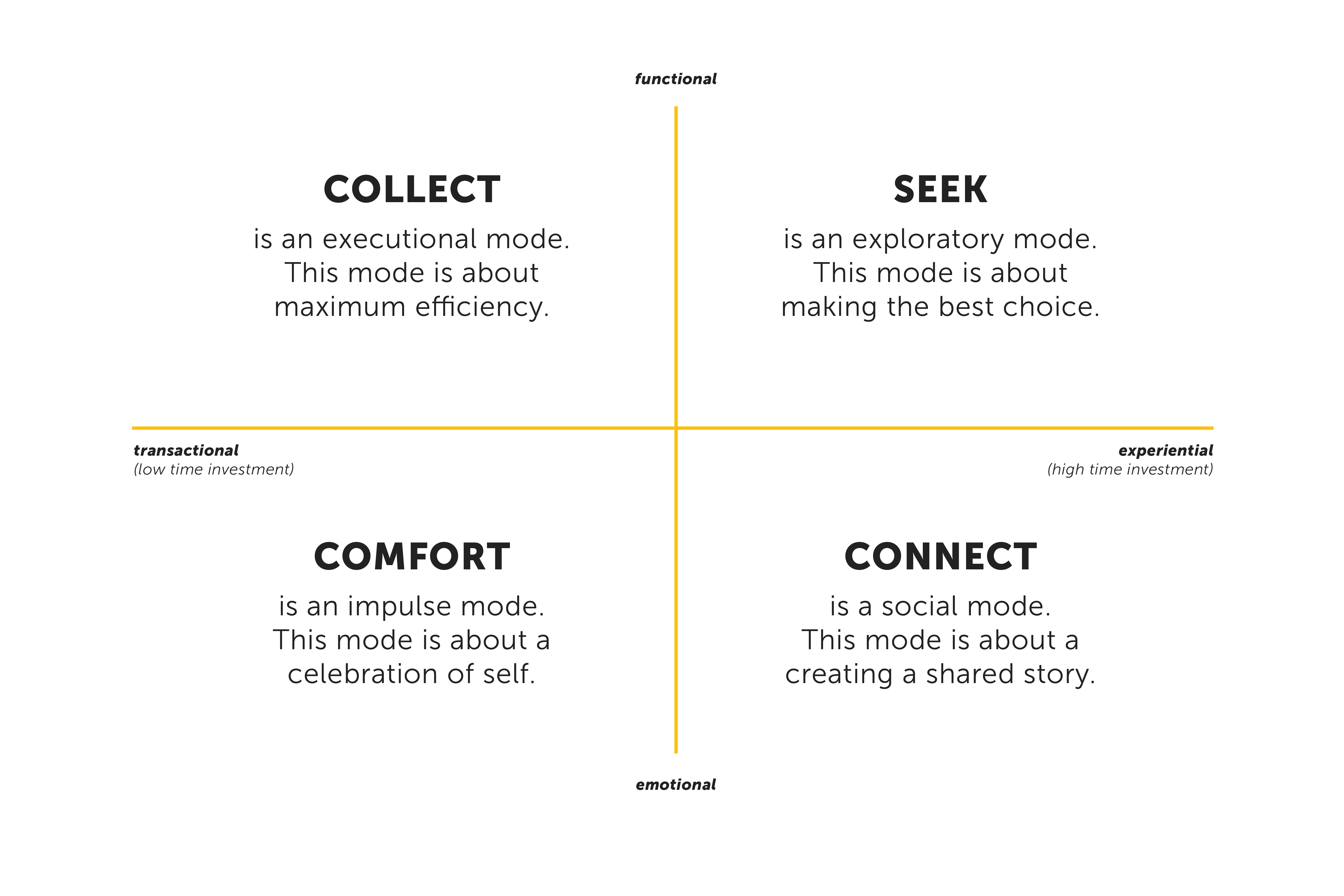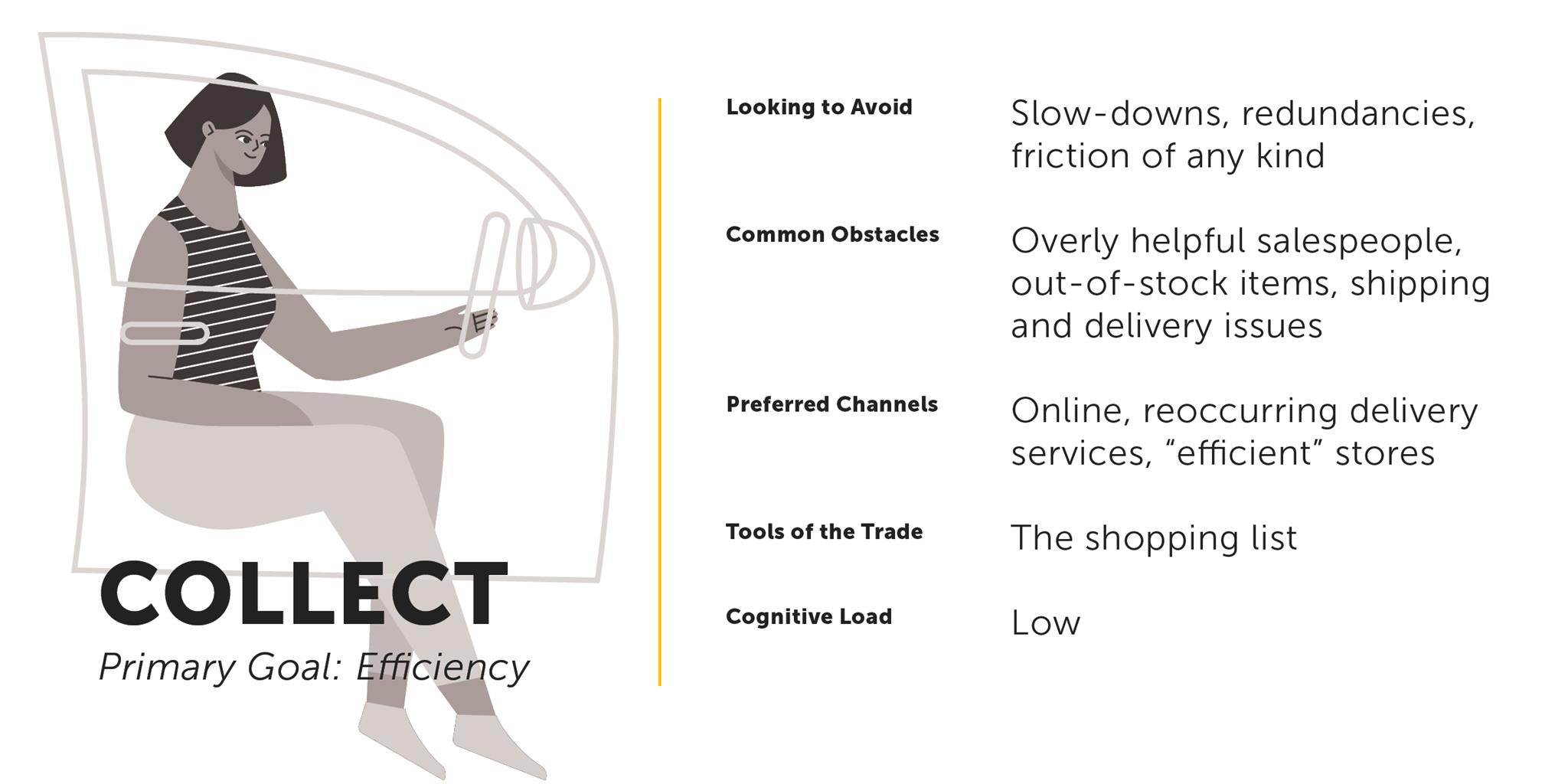Why We Shop
Mastering Modes for Better Retail
In early 2020, the Retail + Restaurants team at EPAM Continuum set off on a mission: Understand how people shop, and in particular, why they continue to shop in brick-and-mortar stores when buying online has never been easier. Now at the beginning of 2021, the retail universe has evolved drastically: COVID-19 has profoundly changed how we interact with places outside our homes. Rapidly shifting pandemic needs (Masks! Sourdough! Toilet paper!) and an uncertain financial future change what we prioritize. For retailers looking for something fixed to hang onto, we have some good news—how we shop has changed; why we shop has not.
Here’s what it boils down to: People notice a gap in their lives and shop to fill it. This gap is material, experiential, emotional, and functional. Shopping is rarely completely irrational or rational. Each purchase, no matter how trivial, is the result of a complex set of values that we juggle on a daily basis. What’s the fastest way to get what I want? Am I getting the right thing? Have I earned this treat this today? Does this company deserve my business? Who we are, combined with who we want to be, directly impacts our decision in the moment to purchase.
If it sounds like a lot of mental math, it is. But shoppers knowingly and unknowingly make these calculations and tradeoffs in every shopping scenario, from cars or carbs. Our mindset and goals determine our purpose for shopping. What we want is the product, but how we go about getting it is called a shopping mode. And the interesting part is that it is possible for us to look at the same product differently depending on which mode has the most influence over how we are shopping. Day to day, the items we are looking for might be the same—say, a cup of coffee—but what the experience we are craving can change.
There are four shopping modes: Collect, Seek, Comfort, and Connect. The mode in which a person shops matters because this is how they will interact with the store based on what they are trying to achieve. Modes can be enabled or inhibited depending on how the retail experience has been embodied. Below the fold, we’ve compiled a more detailed description of what people are looking for in each of these modes—including how they should buy that cup of coffee—and how to meet them where they are.

Becoming a Customer’s Favorite Store
To become a customer’s favorite store, don’t focus on product placement, focus on the mode. Customers avoid experiences that create friction with their existing mode and gravitate towards experiences that excel in fulfilling their given mode's expectations. For instance, if a customer wants to test-drive a new camera but a store only has them boxed up for quick check-out, their desire to confirm if the product is the right fit goes unfilled and they might not make a purchase in that moment. Alternatively, for a customer who previously knows which camera they need based on past experience and are looking to simply collect the item they desire, they might not purchase if there are too many obstacles in the way between them and what they want. The key is designing for how they are shopping and making sure that there are opportunities for a customer to find a satisfying interaction with your store. We found above all, that a customer’s favorite store—where they find the highest enjoyment and most frequent desire to visit—is one that can fulfill the expectations of all four modes. Ikea does this well. Starbucks is a close second.
Here’s a bit more detail about each shopping mode:

Collect is an executional mode. This mode is about maximum efficiency.
When we engage in the collect mode, we have already decided on the product we need, and all that is required is for us to go collect the item. The trigger for this mode normally occurs from a need to replenish an item that has run out or when external factors are dictating what item is required, like a purple shirt for your kid’s kindergarten graduation.
Consumer expectations from the store in this mode are functional and transactional. They are looking to avoid overly helpful salespeople, out-of-stock items, shipping and delivery issues, and general "hassle."

Seek is an exploratory mode. This mode is about making the best choice.
When we engage in the seek mode, we normally have identified a gap or need in our lives that can be filled by a product, but we haven’t yet decided on which specific product to buy. The trigger for this mode normally occurs through aspirations or the desire to explore new options. Maybe we have decided that we are the type of person who aspires to do their own woodworking and needs the right tools, or maybe we have decided that it’s time to buy a nice watch, but we aren’t sure which one is right for us.
Consumer expectations from the store in this mode are functional and experiential. They are looking for the time to assess that what they will buy is the perfect thing for them, but also enough reassurance to avoid buyer’s remorse.
In order to design a store for the ideal seek experience, you must first answer the question of how might we help a customer feel sure about their decision and remove the perceived struggle of returning things that weren't exactly right.
In order to design a store for the ideal collect experience, you must first answer the question of how might we create an experience that makes convenience effortless.

Comfort is an impulsive mode. This mode is about a celebration of self.
When we engage in the comfort mode, we are looking to fulfill a specific emotional desire within ourselves. Maybe we are craving a snack on-the-go or looking for a little trinket that reminds us to treat ourselves. The trigger for this mode is normally external. It could be that we are looking for a memento of a joyous occasion, a celebration of self-worth or escapism from uneasy feelings.
Consumer expectations from the store in this mode are emotional and transactional. They are looking for an experience that deeply aligns with their identity and a lightning-fast desire to feel a certain way. In this mode, they buy something for the way it makes them feel, and this search can be inhibited by a disconnect from their personal values, a lack of novel choices or a layout that doesn’t evoke a feeling.
In order to design a store for the ideal comfort experience, you must first solve for the question of how we might enable personal expression and support the impulsive desires of the consumer.

Connect is a social mode. This mode is about a creating a shared story.
When we engage in the connect mode, we are looking to use the activity of shopping to fulfill a social need for a connected experience with others. The trigger for this mode is the desire to talk with another person about a shared experience. This could be the little shop owner who has a particularly fascinating life story or a group of friends shopping as a bonding activity.
Customer expectations from the store in the connect mode are emotional and experiential. They are looking for something new and someone to talk about it with. The ideal outcome of this mode is a good story to tell about the item and the people who surround it.
In order to design a store for the ideal connect experience, you must first solve for the question of how might we prioritize creating a shared memory for customers that they might recall whenever the look at the product they bought.
Ultimately, modes work together, so look for smart handoffs from one to the other. Looking back at the coffee example, we can see below how the coffee might be the same, but what you are looking for from the experience is different. For example, once you’ve discovered your favorite blend through samples and tastings, make it easy to switch from an exploratory mode to a subscription mode, shifting from “seek” to “collect.”

Curious to learn more? Our Blend Space approach combines modes, channels and journeys to create a holistic retail experience. Send us a note to understand how this approach can help you better meet your customers where they are today and tomorrow.


